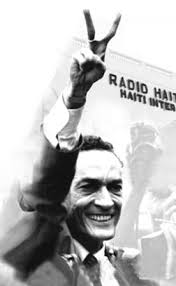 Part of Labanye’s interview went as follows:
Part of Labanye’s interview went as follows:
“Poor Dominique! The person who killed Dominique works at the National
Palace. It is Deputy Mayor Harold Severe, former mayor of Port-au-Prince.
On the day of Dominique’s murder, that is, on 3 April 2000, Severe
contacted So Anne (Sister Anne, nickname for Anne Auguste, a staunch
Aristide supporter); she contacted the ones nicknamed Cadavre, that is,
Franco and Ronald Camille. He told them that they had to do something for
him. He gave them a Daihatsu Charade, beige color, and the Cadavre brothers
contacted the Kosovo gang leader, who was based in Portail Leogane. His
name is Guy Benson, also known as Ti Ponyet. They gave him a Daihatsu
Charade so he could carry out the mission. Then, the Cadavres (Camilles)
promised him that after the mission they would give him $60,000. After the
mission, Benson went down the Delmas Road so that he could get the money
from the Cadavres. But they did not even wait for him to say a word. The
Cadavres killed him, so he did not have an opportunity to talk about the
action”
Labanye himself was murdered in April 2005, but how closely this all lines
up with the court’s recent findings, no?
As to the documents indicating the payments to Oriel Jean – payments that
indicate Jean was in a position of extraordinary intimacy and trust with
the Aristide government – I made detailed notes about them in my notebooks
at the time, and included some of them in my 2005 book on Haiti. They
include substantial payments in 2001 on May 23, June 22, July 20, September
10, November 26 and so on. Jean was not alone in receiving such largess,
and I also made notes of payments to a number of other entities and
individuals, some of whom are U.S. citizens who have been active in Haiti
for a number of years, though not in a capacity that would explain the
nature of the payments I saw records of.
I saw these documents during a May 2005 interview with a high-ranking
official of the Banque de la Republique d’Haiti. In other words, these
documents were already in possession of the proper authorities of the
Haitian state. What the state then did with them you would have to ask
them.
The existence of records of these payments to Oriel Jean was also reported
by Haiti’s Radio Metropole as far back as December 2004, as can be viewed
here:
http://www.metropolehaiti.com/metropole/full_une_fr.php?id=9374&action=print
The fact that Mr. Aristide used the Haitian state as a private piggy bank
has been demonstrated in investigations by bodies such as the Unite
Centrale de Renseignements Financiers (UCREF) which found that “Aristide’s
government illegally pumped at least $21 million of his country’s meager
public funds into private firms that existed only on paper and into his
charities.” The article by the Miami Herald’s Jacqueline Charles’ on
UCREF’s findings can be read here: http://tiny.cc/vpk19w
The inquiry of the Commission d’Enquete Administrative, headed by Paul
Denis and Sylvie Bajeux, also chronicled an extraordinarily wide variety of
financial misdeeds during Mr. Aristide’s time in office. Much of that report can be read here: http://tiny.cc/jtk19w
As it happens, Mirlande Liberus, whom the Haitian court is alleging Aristide outsourced the Jean Dominique killing to, appears quite prominently within the report’s pages.
Given the scrupulous documentation of these two reports, one might ask why has no one within their pages been brought to trial for pillaging the Haitian state, despite the fact that the government in Haiti has changed three times since their occurrence?
The answer: Because once the wall of impunity is toppled, then Haiti’s political class – and those outside of Haiti who have aided them – will be held accountable for their actions, they will have to fear the courts and justice and, with very few exceptions, that is the last thing that many involved in Haiti’s political life want.
MD